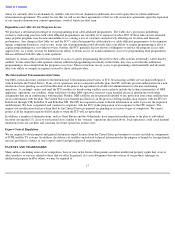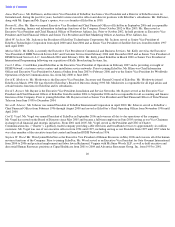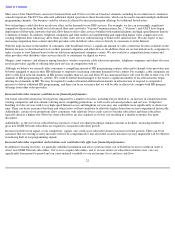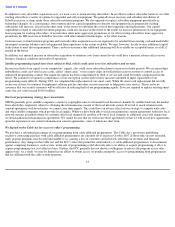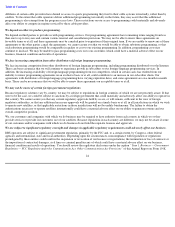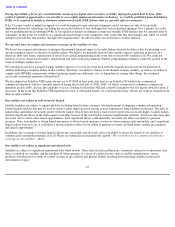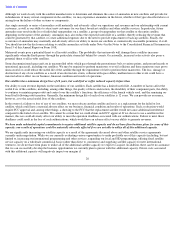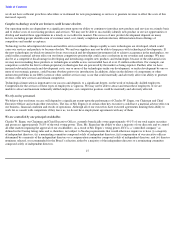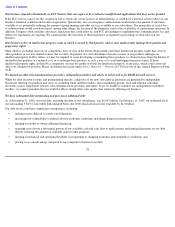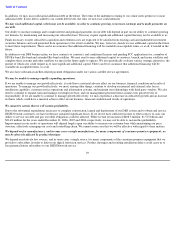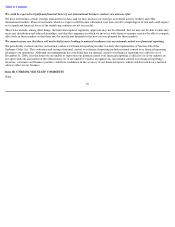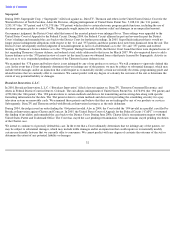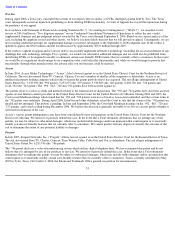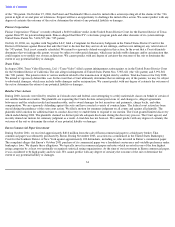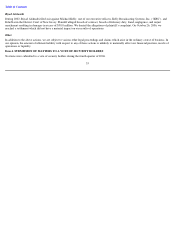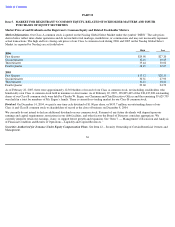Dish Network 2007 Annual Report Download - page 33
Download and view the complete annual report
Please find page 33 of the 2007 Dish Network annual report below. You can navigate through the pages in the report by either clicking on the pages listed below, or by using the keyword search tool below to find specific information within the annual report.
Table of Contents
Although we work closely with the satellite manufacturers to determine and eliminate the cause of anomalies in new satellites and provide for
redundancies of many critical components in the satellites, we may experience anomalies in the future, whether of the types described above or
arising from the failure of other systems or components.
Any single anomaly or series of anomalies could materially and adversely affect our operations and revenues and our relationship with current
customers, as well as our ability to attract new customers for our direct broadcast satellites and other satellite services. In particular, future
anomalies may result in the loss of individual transponders on a satellite, a group of transponders on that satellite or the entire satellite,
depending on the nature of the anomaly. Anomalies may also reduce the expected useful life of a satellite, thereby reducing the revenue that
could be generated by that satellite, or create additional expenses due to the need to provide replacement or back-up satellites. Finally, the
occurrence of anomalies may materially and adversely affect our ability to insure our satellites at commercially reasonable premiums, if at all.
You should review the disclosures relating to satellite anomalies set forth under Note 4 in the Notes to the Consolidated Financial Statements in
Item 15 of this Annual Report on Form 10-K.
Meteoroid events pose a potential threat to all in-orbit satellites. The probability that meteoroids will damage those satellites increases
significantly when the Earth passes through the particulate stream left behind by comets. Occasionally, increased solar activity also poses a
potential threat to all in-orbit satellites.
Some decommissioned spacecraft are in uncontrolled orbits which pass through the geostationary belt at various points, and present hazards to
operational spacecraft, including our satellites. We may be required to perform maneuvers to avoid collisions and these maneuvers may prove
unsuccessful or could reduce the useful life of the satellite through the expenditure of fuel to perform these maneuvers. The loss, damage or
destruction of any of our satellites as a result of an electrostatic storm, collision with space debris, malfunction or other event could have a
material adverse effect on our business, financial condition and results of operations.
Our satellites have minimum design lives of 12 years, but could fail or suffer reduced capacity before then.
Our ability to earn revenue depends on the usefulness of our satellites. Each satellite has a limited useful life. A number of factors affect the
useful lives of the satellites, including, among other things, the quality of their construction, the durability of their component parts, the ability
to continue to maintain proper orbit and control over the satellite’s functions, the efficiency of the launch vehicle used, and the remaining on-
board fuel following orbit insertion. Generally, the minimum design life of each of our satellites is 12 years. We can provide no assurance,
however, as to the actual useful lives of the satellites.
In the event of a failure or loss of any of our satellites, we may relocate another satellite and use it as a replacement for the failed or lost
satellite, which could have a material adverse effect on our business, financial condition and results of operations. Such a relocation would
require FCC approval and, among other things, a showing to the FCC that the replacement satellite would not cause additional interference
compared to the failed or lost satellite. We cannot be certain that we could obtain such FCC approval. If we choose to use a satellite in this
manner, this use could adversely affect our ability to meet the operation deadlines associated with our authorizations. Failure to meet those
deadlines could result in the loss of such authorizations, which would have an adverse effect on our ability to generate revenues.
We have made substantial capital commitments to acquire additional satellite capacity and do not have firm business plans for some of this
capacity; our results of operations could be materially adversely affected if we are not able to utilize all of this additional capacity.
We are significantly increasing our satellite capacity as a result of the agreements discussed above and other satellite service agreements
currently under negotiation. While we are currently evaluating various opportunities to make profitable use of this capacity (including, but not
limited to, increasing our international programming and other services, expanding our local and HD programming, offering fixed satellite
service capacity on a wholesale commercial basis (rather than direct to consumers) and supplying satellite capacity for new international
ventures), we do not have firm plans to utilize all of the additional satellite capacity we expect to acquire. In addition, there can be no assurance
that we can successfully develop the business opportunities we currently plan to pursue with this additional capacity. Future costs associated
with this additional capacity will negatively impact our margins if
26



